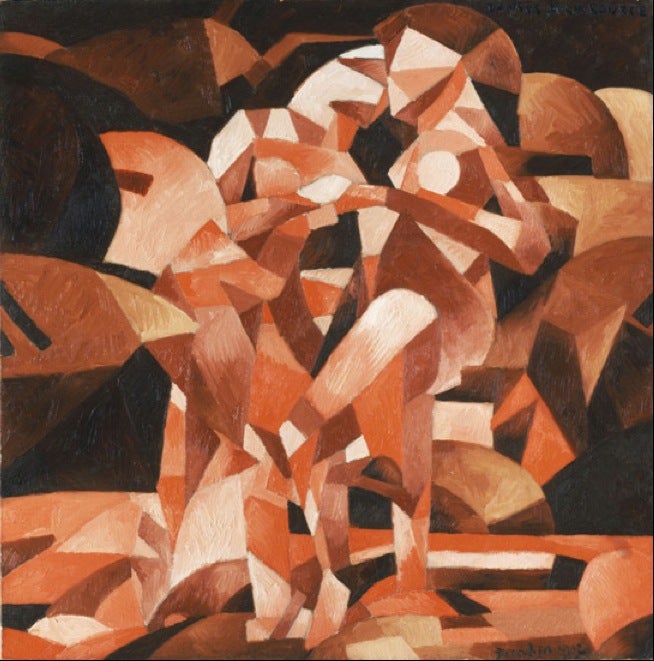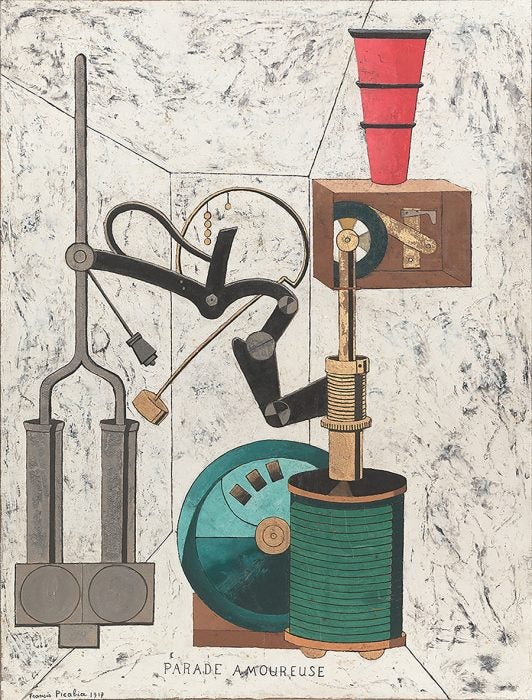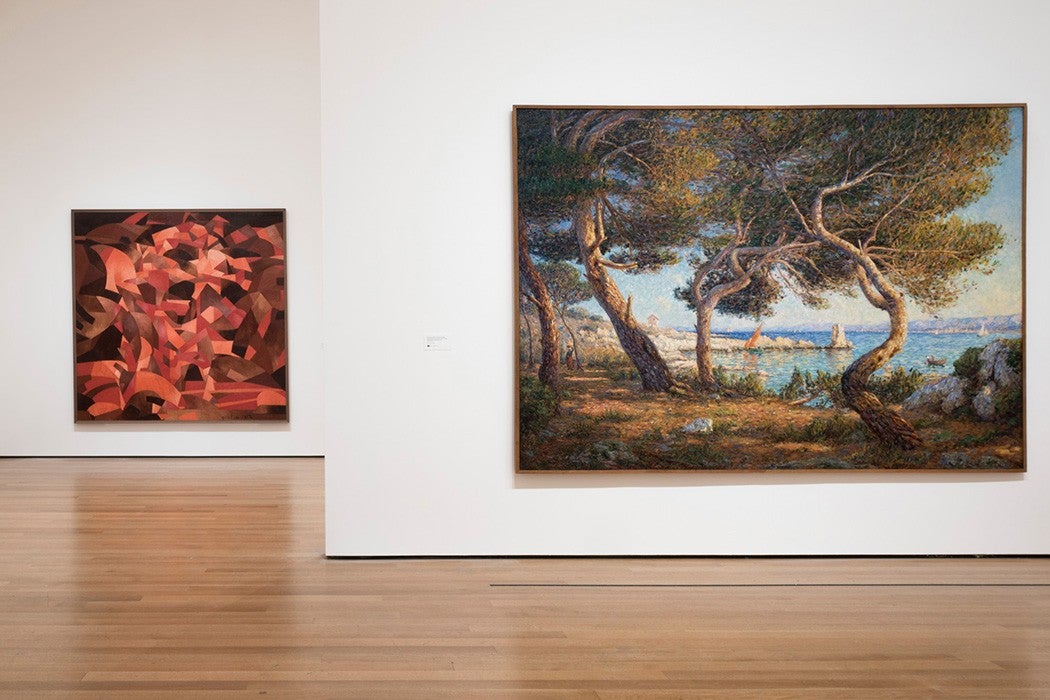The Museum of Modern Art’s retrospective of Francis Picabia’s work was been celebrated by critics for shining a spotlight on one of modernism’s most confounding founders. ARTnews called the exhibit “one of the best shows of the year,” and Forbes declared it “exhilarating.”
What struck most visitors was the exhibit’s sheer variety. Throughout his career, Picabia (1879–1953) careened between styles, flipping from cubism to dadaism, from abstraction to portraiture. In fact, he rarely stuck with a style for more than a few years. A fiercely independent artist, he ignored movements and shunned trends. “If you want to have clean ideas, change them as often as your shirt,” Picabia advised.
Picabia’s desire for variety can be traced back to a key moment in his career: when he first discovered New York City. Just over a century ago, the artist made his first visit to the new world, becoming an overnight sensation. His New York experiences confirmed Picabia’s desire for artistic independence and freed him to reinvent himself as often as he liked. In 1913, Picabia became the shape-shifting painter we celebrate today.
At the start of his career, the main difference between Picabia and his peers was money. While Picasso struggled to scrape together the cash to pay the coal merchant, Picabia bought a new sports car every year. His father, a well-to-do Cuban-born Spaniard, married an equally wealthy French woman, and their son, born in 1879, lacked for nothing. The adult Picabia was dark and handsome, with deep-set eyes and thick black hair, which he wore swept back from his forehead. Women found Picabia charming, and he was never without a wife, a mistress, or both.
Picabia made his name in the salons of Paris around 1906 with a series of competent but unremarkable impressionist paintings. Recognizing that he was working in an outdated style, he joined forces with one of the hottest groups of artists in Paris: the Puteaux Group cubists. This circle of painters, among them Albert Gleizes, Jean Metzinger, Fernand Léger, and Marcel Duchamp, sought to create a new art form that disassembled subjects into their component parts and reassembled them from multiple perspectives at once. Like many movements in Paris, the Puteaux Group asserted the primacy of its ideas, bitterly resented rival groups, and insisted on artistic orthodoxy from its members. Picabia began his own cubist experiments with works such as Dances at the Spring, 1912, a complex arrangement of overlapping flat surfaces that, if you look in the right place, resolves into two figures dancing.

In late 1912, Picabia was asked to lend canvases for an exhibition organized in New York by a group called the Association of American Painters and Sculptors (AAPS). The AAPS planned a massive exhibition in February and March of 1913 to show off the work of American progressive artists and introduce New York audiences to European modernism. Picabia decided not only to lend four paintings to the exhibition, but also to travel to New York, a city that represented all that was exciting and modern. He was the only European artist to make the journey—no one else could afford it. But Picabia, for whom the trip was no hardship, couldn’t resist the opportunity. He and his wife, Gabrielle, set off for America in January 1913.
They found New York in an uproar. The art on display at the 69th Regiment Armory, which lent its name to the show, stunned audiences. Introduced for the first time to works by Matisse, Picasso, Braque, Duchamp, Kandinsky, and Léger, audiences reeled. Most observers saw the art as weird, disturbed, even deviant. The Evening World declared: “No Imagination Outside the Psychopathic Ward of Bellevue or the Confines of Matteawan Can Conceive Without Actually Seeing It What a Cubist Picture is Like.” (Matteawan was the state hospital for the criminally insane.) Reporters suggested the artists were either deranged or hucksters mocking the credulity of audiences.
Desperate for someone to explain the art, newspapers turned to Picabia, the only European artist at hand. Picabia’s paintings had received their share of insults; Dances at the Spring was described as “a cat having fits in a patch of tomatoes.” But the opportunity to interview a genuine cubist was too great to be missed. A reporter for The Sun noted, with ponderous humor, that Picabia had “nothing cubical about him, being somewhat rotund.” The same writer also declared, in apparent surprise, that “M. Picabia does not look like a really improper person, and his wife is the quintessence of propriety.”
Picabia provided lengthy interviews discussing his art, which he described as “moods expressed in form.” He offered an expressionistic explanation of his style, telling the New York Times:
I saw what you call your “skyscrapers.” Did I paint the Flatiron Building, the Woolworth Building, when I painted my impressions of these “skyscrapers” of your great city? No! I gave you the rush of upward movement, the feeling of those who attempted to build the Tower of Babel—man’s desire to reach the heavens, to achieve Infinity.
It’s not clear if this made sense to the journalists, who were struggling to understand any art that wasn’t strictly representational, but they nevertheless ate it up. And Picabia had a marvelous time dishing it out. He seems to have treated interviews as a game, reinventing himself for every newspaper. One reporter described him as deadly serious and noted that he didn’t smile the entire interview. Another emphasized his charm. The Times, which devoted an entire page to Picabia, described him as barely in control of a ferocious temper and claimed he was 45 years old. (He was 34.) The Times also told readers Picabia was “already famous in France” (he wasn’t) and explained he had “outfutured the Futurists” and “outcubed the Cubists.” Whatever that meant.
Baiting the media wasn’t the only delight to be found in New York. Picabia declared, “New York is the cubist city, the futurist city. It expresses modern thought in its architecture, its life, its spirit.” He was welcomed into New York’s artistic and bohemian communities. He became a regular at the Greenwich Village salons of socialite Mabel Dodge, where he and Gabrielle hobnobbed with anarchists, suffragettes, labor organizers, artists, and poets. He also befriended modern art promoter Alfred Stieglitz. Stieglitz, who went on to sponsor and eventually marry Georgia O’Keeffe, ran a small but influential gallery known simply as 291 (for its address at 291 Fifth Avenue).
Stieglitz was a contrarian who rejected anything mainstream out of principle. The more an idea swam against the tide, the more he liked it. He didn’t let consistency hold him back. Even though he had promoted European art at 291 for years, as soon as artists such as Matisse and Picasso became famous, he no longer wanted to exhibit their work. Stieglitz was also a photographer. He believed that since photography accurately represented the world, painting should no longer bother with representation. Instead, painting should begin where representation ends. Stieglitz argued for “pure art”—art without reference to the physical world, i.e., abstraction.
We’re so accustomed to abstract art that it no longer surprises us, but removing the subject from art was a tremendous step. Even for Picasso, abstraction was a bridge too far. His most baffling cubist paintings retain a subject, no matter how well hidden. However, in 1913, artists such as Wassily Kandinsky were taking their first steps into abstraction. The Armory Show included an abstract by Kandinsky that Stieglitz declared the most important work at the exhibition.
Stieglitz’s arguments struck a chord with Picabia. Two days after the Armory Show closed, Stieglitz opened a one-man exhibit of work Picabia had completed in New York, work that revealed that Picabia had left cubism behind. He told the New York Tribune he was seeking “entirely unfettered, spontaneous, ever-varying means of expression.” He added: “Objective expression is strictly barred.”
Picabia intended to spend only two weeks in New York, but he remained in the city until April of 1913, finally returning to Paris fired up with enthusiasm, upon which he immediately wrote to Stieglitz to report on his progress. When he exhibited his abstractions, the Puteaux Group was baffled and affronted by his defection. Picabia dismissed their insistence on cubist dogma. He had absorbed Stieglitz’s independence and saw no point in loyalty to the movement.

But Picabia didn’t even stay loyal to abstraction. He was brought—briefly—into contact with the real world with the outbreak of World War I. He faced the prospect of being sent to the front. However, his family pulled strings to secure him a cushy job as a driver for a general, who had little patience for the artist’s less-than-military habits. So more strings were pulled, and Picabia was assigned to travel to Cuba to purchase sugar for the army. But alas for the French army: The ship on which Picabia sailed stopped off in New York, and so, too, did the artist.
He reunited with Stieglitz and again spent hours at 291. This time, Picabia drew detailed machines—lamps, spark plugs, carburetors. With these “mechanomorphs,” Picabia rejected abstraction—or did he? The drawings have the precision of technical illustrations, with straight lines and careful shading, and yet they are labeled as portraits. A detailed drawing of a camera is titled, in French, Here, This is Stieglitz Here. The mechanomorphs are a different kind of abstraction, a theoretical distillation of a subject seeking its essence.
Picabia never completely abandoned abstraction, but he saw no need to hold himself to one style. He did finally complete his mission to Cuba, but spent the rest of the war avoiding France altogether. After the war, he embraced the anti-art dada movement, which appealed to his sense of humor. Picabia delighted in nonsense art and absurdist dadaist performances—until the members of the movement began to take themselves too seriously. He walked away without a second glance. “When I have finished smoking,” he said, “I am not interested in the butts.” Sometimes he painted realistically, though with such saccharine sincerity that the works bleed into satire. Sometimes he painted pure abstractions, dots and lines on colored backgrounds. He kept chopping and changing until he died in 1953.
For many artists, the transformative moment is the moment they discover their style—the style they will refine their entire career. For Picabia, the transformative moment came when he realized he could throw off a style the moment it no longer suited him. “What I like is to invent, to imagine, to make of myself at every moment a new man, and then, to forget him, to forget everything,” he wrote in 1923. The experience of inventing himself in New York inspired Picabia to go on inventing himself, again and again, for the rest of his life.
Editor’s note: This piece was updated in August 2019.







